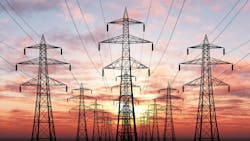Smart Grids are the Key to Successful Decarbonized Power
Decarbonizing electricity generation is among the world’s most critical yet complex challenges. Fortunately, many global governments now share a focus on increasing energy supplies from renewable resources and have set net zero targets.
The US has issued urgent mandates to transition the grid to 100% carbon-free electricity. The remaining G7 advanced economies have agreed to rapidly work towards “predominantly decarbonized” electricity.
The world is already successfully generating vast amounts of renewable energy to reduce climate-change impacted emissions. But this in itself presents a major challenge: the integration of hundreds of gigawatts of new green energy, including solar and wind, into ageing and siloed grid infrastructures.
In addition, renewables can only produce power intermittently, so energy players need to get better at moving power to the places where renewable energy resources aren’t available.
Another challenge lies in the prolific rise of electric vehicles and energy-hungry data centres power demand is growing and increasingly unpredictable.
The Age of Smart Grids
The rise in power demand and the growth of renewable energy sources call for rapid grid transformation, enhanced energy storage capacity, and the integration of advanced technologies for effective smart grid management.
As physical grids become less centralized and comprise multiple power sources, flexibility and visibility are critical. To deal with variable supply and demand, as well as green and conventional energies, modern grid infrastructure needs to be smart, reliable and resilient.
The good news is the big technologies we already know about are already supporting power companies in their transformation. The industrial internet of things (IIoT), enhanced with artificial intelligence (AI), augmented reality (AR), machine learning and the cloud, are already driving connectivity, transparency, and collaboration across grid operators and power companies.
Electric utility companies are leveraging industrial technologies to analyze power supply and demand (forecasting), consumption patterns and weather conditions. These solutions enable companies to optimize load balancing, enhance reliability, and reduce power wastage.
Digital Twins and Data Insights
Modern grid ecosystems can be significantly enhanced with the use of digital twins. Serving as virtual representations of the smart grid network's physical and digital components (generation, transmission, distribution, consumer and distributed assets), digital twins enable stakeholders to dynamically analyze and respond to operational events.
Real-time data sharing has also emerged as a key solution for connecting power companies to better insights. Power industry players can analyze and share information to make more informed decisions to drive resilience and profitability.
All of this means that a solid data framework is a must for energy firms. With flexible and solid data infrastructure that supports secure, efficient data sharing, everyone from energy generators to grid operators to utilities and service providers can ensure supply meets demand.
Integrating information from an increasingly diverse group of data sources is key to breaking down silos and building a holistic view of the grid so power companies keep it reliable and resilient.
Power industry leaders are also speeding up their investments in distributed energy resources (DER) – smaller generation units that are located on the consumer’s side of the meter. This can lend more control at the ‘grid edge’, such as electric vehicles, water heaters, or thermostats. This also means customers can be more informed about their usage, in real time, and given incentives to benefit the wider grid supply.
This type of investment requires companies to collaborate more deeply with connected ecosystems of customers, suppliers, business partners and others through edge-to cloud data collection and visualization capabilities.
Utilities Technology in Action
An example of a major global firm using technology to lead the energy transition can be seen in Europe’s EDP Renewables.
To optimize the energy production of its wind farms, EDP deployed hybrid data infrastructure and data services to collect insights from two million data streams and perform calculations for more than 10,000 wind turbines. This data lets EDP monitor turbine performance, anticipate maintenance needs and extend asset life.
In another case study, US-based Dominion Energy is using cloud-based services to aggregate data from its diverse DER sources. This type of data increasingly interests utilities and industrial consumers who want or need to validate their own net-zero commitments by proving they are using power from low-carbon sources. Dominion is building customer loyalty and competitively differentiating itself by offering this real-time energy data.
Both Dominion and EDP are solid examples of companies giving themselves a competitive advantage by using innovative and advanced technologies to create innovative solutions.
Modern grids of the future will be dynamically, transparently and securely connected to an ecosystem community of energy stakeholders, including but not limited to, electric grid owners and operator, generation and renewable energy providers, service providers, regulators, developers, data analysts, meteorologists, and consumers.
The key to next-generation power grid networks lies in building a foundation with a single source of truth through technology, with a trusted and connected energy ecosystem community.
About the Author
Ann Moore
Ann Moore, Industry Principal – Power & Utilities, AVEVA
